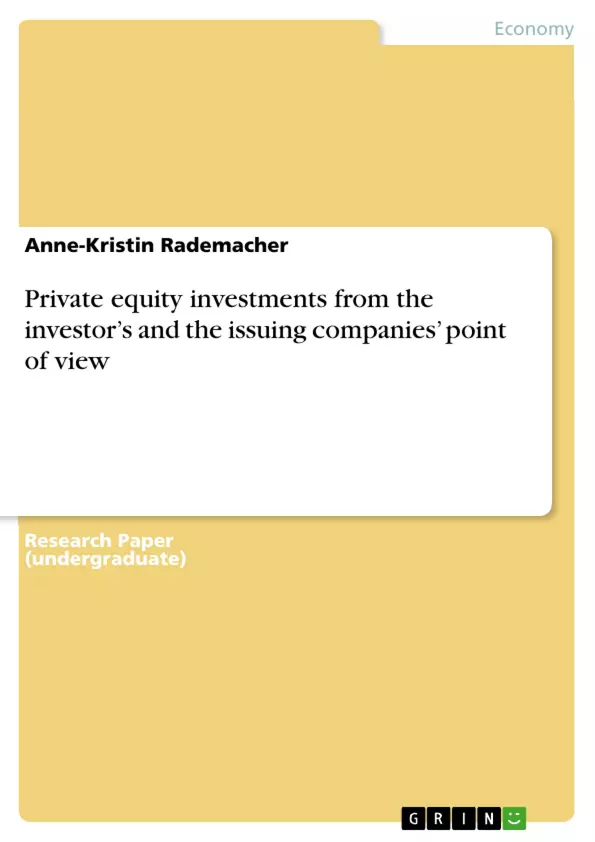The paper on hand aims at analyzing the financial model private equity from participants’ point of view. The introduction has shown the importance for the overall economy. Questions of the paper are: what are the criteria for successful investments for both parties; what are the advantages respectively difficulties from the perspectives of investors and issuers of private equity?
In order to systematically approach the questions the author first provides the fundamentals of the concept. In a second step benefits and risks for the participants in private equity investments will be described. A simultaneous assessment of these will result in an overview reflecting potential profits and losses.
The analysis focusses on theoretical descriptions; practical applications will not be considered. Information and data gathering is based on secondary literature.
Inhaltsverzeichnis (Table of Contents)
- Introduction
- Objective of the paper
- Methodology
- Fundamentals of PE investments
- Definition of the term private equity investments
- Participants on the PE market
- Process of PE investments and negotiation criteria
- Application of PE investments in the company life cycle
- Benefits and risks in PE investments
- Breaking down the critical points between the investors: LP and GP
- Breaking down the critical points between investor and target
- Weighting the power between investor and issuer
- Conclusion
Zielsetzung und Themenschwerpunkte (Objectives and Key Themes)
The paper aims to provide a comprehensive analysis of private equity investments from the perspectives of both investors and the companies that issue them. It explores the fundamentals of private equity, including its definition, participants, processes, and applications in the company life cycle. The paper also examines the benefits and risks associated with private equity investments, delving into the critical points between different stakeholders.
- Fundamentals of private equity investments
- Participants in the private equity market
- Benefits and risks associated with private equity investments
- Critical points between investors and target companies
- Power dynamics between investors and issuers
Zusammenfassung der Kapitel (Chapter Summaries)
- Introduction: This chapter introduces the objective and methodology of the paper, setting the stage for the subsequent analysis of private equity investments.
- Fundamentals of PE investments: This chapter explores the definition of private equity investments, identifies the key participants in the market, and outlines the processes and negotiation criteria involved in private equity transactions. It also examines the role of private equity in different stages of the company life cycle.
- Benefits and risks in PE investments: This chapter delves into the critical points between investors, specifically Limited Partners (LPs) and General Partners (GPs), as well as between investors and target companies. It analyzes the power dynamics in these relationships and examines the potential benefits and risks for all involved parties.
Schlüsselwörter (Keywords)
Private Equity, Investors, Issuing Companies, Benefits, Risks, Limited Partners, General Partners, Venture Capital, Company Life Cycle, Power Dynamics, Negotiation Criteria, Investment Processes.
- Arbeit zitieren
- Anne-Kristin Rademacher (Autor:in), 2013, Private equity investments from the investor’s and the issuing companies’ point of view, München, GRIN Verlag, https://www.grin.com/document/213651



